Are you wondering what an XML sitemap is and how to add it to your WordPress website?
An XML sitemap helps search engines easily navigate through your website content. It gives them a list of all your content in a machine-readable format.
In this article, we will explain what an XML sitemap is and how you can easily create a sitemap in WordPress.
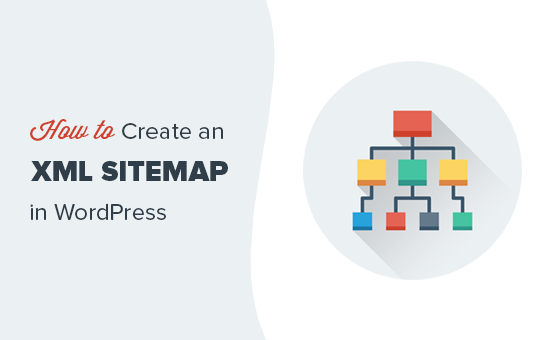
What Is an XML Sitemap?
An XML sitemap is a file that lists all your website content in an XML format so that search engines like Google can easily discover and index your content.
Back in the early 2000s, government websites used to have a link on their main pages titled ‘Sitemap’. This page usually contained a list of all the pages on that website.
While some websites still have HTML sitemaps today, the overall usage of sitemaps has evolved over the years.
Today sitemaps are published in an XML format instead of HTML, and their target audience is search engines and not people.
Basically, an XML sitemap is a way for website owners to tell search engines about all the pages that exist on their website.
It also tells search engines which links are more important than others and how frequently you update your website.
While XML sitemaps will not boost your search engine rankings, they allow search engines to crawl your website better. This means they can find more content and start showing it in search results, thus resulting in more search traffic and improved SEO rankings.
Why You Need an XML Sitemap
Sitemaps are extremely important from a search engine optimization (SEO) point of view.
Simply adding a sitemap will not affect your search rankings. However, if there is a page on your site that is not indexed, then a sitemap will let search engines know about that page.
Sitemaps are extremely useful when you first start a blog or create a new website because most new websites don’t have any backlinks. This makes it harder for search engines to discover all of your content.
This is why search engines like Google and Bing allow new website owners to submit a sitemap in their webmaster tools. This allows their search engine bots to easily discover and index your content (more on this later).
Sitemaps are equally important for established popular websites as well. They allow you to highlight which parts of your website are more important and which parts are more frequently updated so that search engines can index your content accordingly.
That being said, let’s take a look at how to create an XML sitemap in WordPress.
Video Tutorial
If you prefer written instructions, just keep reading.
There are several ways to create an XML sitemap in WordPress. We will show you three popular methods to create an XML sitemap in WordPress. We will also show you how to submit your sitemaps to search engines and use them to grow your site.
Method 1: Creating an XML Sitemap in WordPress Without a Plugin
This method is very basic and limited in terms of features.
Before August 2020, WordPress didn’t have built-in sitemaps. However, in WordPress 5.5, they released a basic XML sitemap feature.
This feature allows you to automatically create an XML sitemap in WordPress without using a plugin. You can simply add wp-sitemap.xml at the end of your domain name, like this:
https://www.example.com/wp-sitemap.xml
WordPress will show you the default XML sitemap.
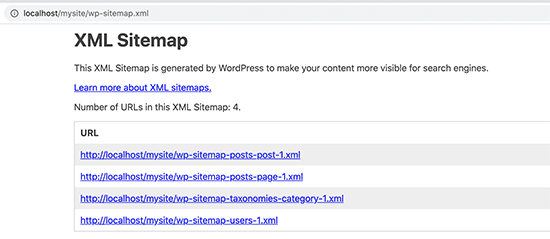
This XML sitemap feature was added to WordPress to make sure that any new WordPress website does not miss out on the SEO benefits of an XML sitemap.
However, it is not very flexible, and you cannot easily control what to add or remove from your XML sitemaps.
Luckily, almost all top WordPress SEO plugins come with their own sitemap functionality. These sitemaps are better, and you can control which content to remove or exclude from your WordPress XML sitemaps.
Method 2: Creating an XML Sitemap in WordPress Using AIOSEO
The easiest way to create an XML sitemap in WordPress is by using the All in One SEO (AIOSEO) plugin for WordPress.
It is the best WordPress SEO plugin on the market, offering you a comprehensive set of tools to optimize your blog posts for SEO.
First, you need to install and activate the All in One SEO plugin. For more details, see our step-by-step guide on how to install a WordPress plugin.
The sitemap feature is also available in AIOSEO Free version. However, to get advanced news sitemaps and video sitemaps, you will need the Pro version.
Upon activation, go to the All in One SEO » Sitemaps page to review the sitemap settings.
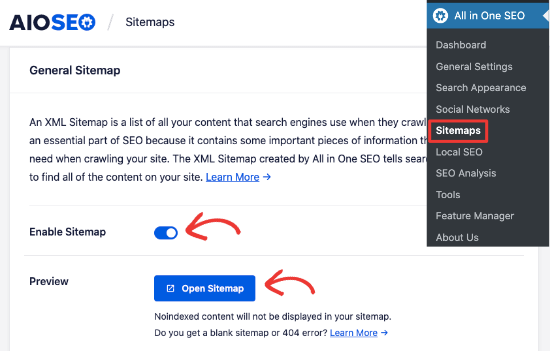
By default, All in One SEO will enable the Sitemap feature for you and replace the basic WordPress sitemaps.
You can click on the ‘Open Sitemap’ button to preview it to see what it looks like. You can also view your sitemap by adding sitemap.xml to your website’s URL, such as:
https://www.example.com/sitemap.xml
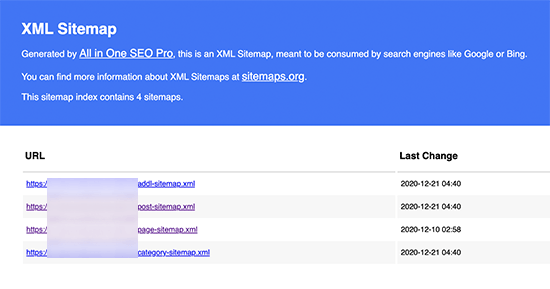
As a beginner, you don’t need to do anything, as the default settings will work for all kinds of websites, blogs, and online stores.
However, you can customize the sitemap settings to control what you want to include in your XML sitemap.
Simply scroll down to the ‘Sitemap Settings’ section.
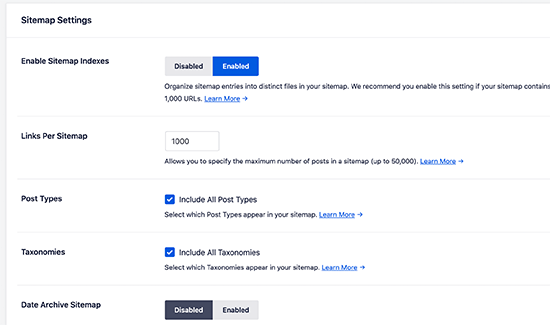
This section gives you options to manage sitemap indexes and include or exclude post types and taxonomies (categories and tags). You can also enable XML sitemaps for date-based archives and author archives.
All in One SEO automatically includes all your WordPress content in XML sitemaps. But what if you have stand-alone pages like a contact form, a landing page, or Shopify store pages that are not part of WordPress?
Well, AIOSEO is the only plugin that lets you add external pages to your WordPress sitemap. Simply scroll to the ‘Additional Pages’ section and turn it on. This will show you a form where you can add any custom pages that you want to include.
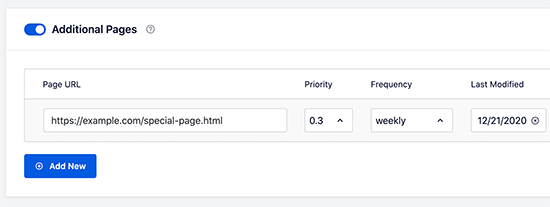
You simply need to add the URL of the page that you want to include and then set a priority where 0.0 is the lowest and 1.0 is the highest. If you are unsure, then we recommend using 0.3.
Next, choose the frequency of updates and the last modified date for the page.
You can click on the ‘Add New’ button if you need to add more pages.
Don’t forget to click on the ‘Save Changes’ button to store your settings.
Excluding Specific Posts and Pages from your XML Sitemap
All in One SEO allows you to exclude any post or page from your XML sitemaps. You can do this by clicking on the ‘Advanced Settings’ section on the All in One SEO » Sitemaps page.
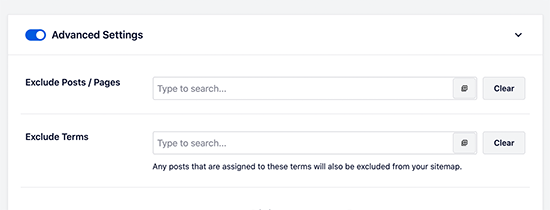
You can also remove a post or page from your XML sitemaps by making it no-index and no-follow. This will block search engines from showing that content in search results.
Simply edit the post or page that you want to exclude and scroll down to the AIOSEO Settings box below the editor.
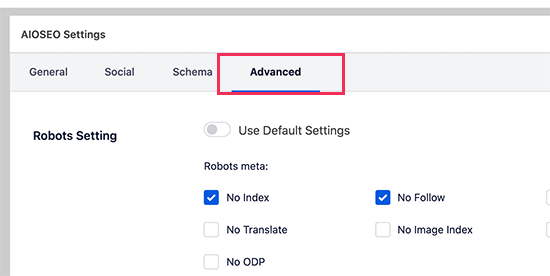
From here, you need to switch to the Advanced tab and check the boxes next to the ‘No Index’ and ‘No Follow’ options.
Creating Additional Sitemaps
All in One SEO allows you to create additional sitemaps, such as a video or news sitemap.
You can create a video sitemap if you regularly embed videos in your blog posts or pages. This will allow search engines to display posts in search and video search results along with a video thumbnail.
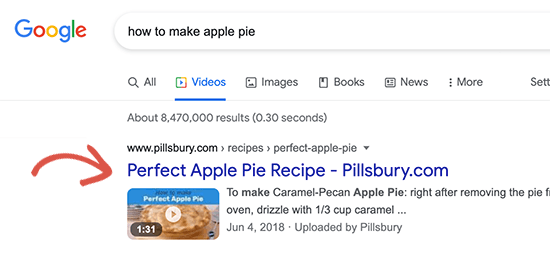
You can also create a News sitemap if you run a news website and want to appear in Google News search results.
Simply go to All in One SEO » Sitemaps and switch to the Video Sitemap or News Sitemap tabs to generate these sitemaps.
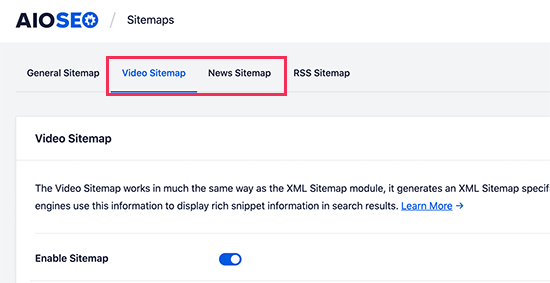
Overall, AIOSEO is the best WordPress plugin because it gives you all the flexibility and powerful features at a very affordable price.
Method 3: Creating an XML Sitemap in WordPress Using Yoast SEO
If you are using Yoast SEO as your WordPress SEO plugin, then it also automatically turns on XML sitemaps for you.
First, you need to install and activate the Yoast SEO plugin. For more details, see our step-by-step guide on how to install a WordPress plugin.
Upon activation, go to the SEO » General page and switch to the ‘Features’ tab. From here, you need to scroll down to the ‘XML Sitemap’ option and make sure that it is turned on.
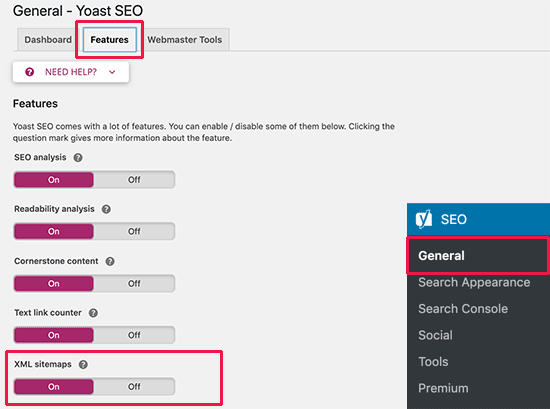
Next, click on the ‘Save Changes’ button to store your changes.
To verify that Yoast SEO has created an XML sitemap, you can click on the question mark icon next to the ‘XML sitemaps’ option on the page.
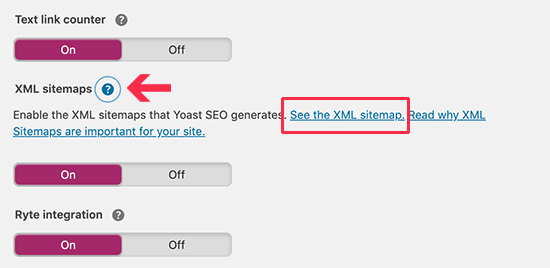
After that, click on the ‘See the XML Sitemap’ link to view your live XML sitemap generated by Yoast SEO.
You can also find your XML sitemap by simply adding sitemap_index.xml at the end of your website address. For example:
https://www.example.com/sitemap_index.xml
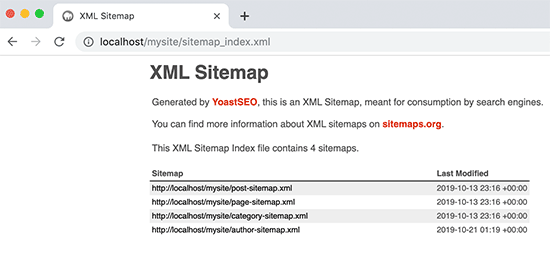
Yoast SEO creates multiple sitemaps for different types of content. By default, it will generate sitemaps for posts, pages, authors, and categories.
Submitting Your XML Sitemap to Search Engines
Search engines are quite smart at finding a sitemap. Whenever you publish new content, a ping is sent to Google and Bing to inform them about changes in your sitemap.
However, we recommend that you submit the sitemap manually to ensure that search engines can find it.
Submitting Your XML Sitemap to Google
Google Search Console is a free tool offered by Google to help website owners monitor and maintain their site’s presence in Google search results.
Adding your sitemap to Google Search Console helps it quickly discover your content, even if your website is brand new.
First, you need to visit the Google Search Console website and sign up for an account.
After that, you will be asked to select a property type. You can choose a domain or a URL prefix. We recommend choosing a URL prefix as it is easier to set up.
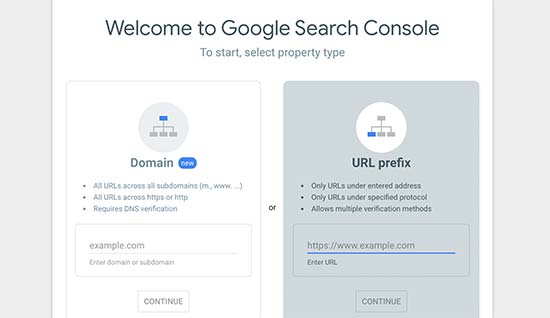
Enter your website’s URL and then click on the ‘Continue’ button.
Next, you will be asked to verify ownership of the website. You will see multiple methods to do that. We recommend using the HTML tag method.
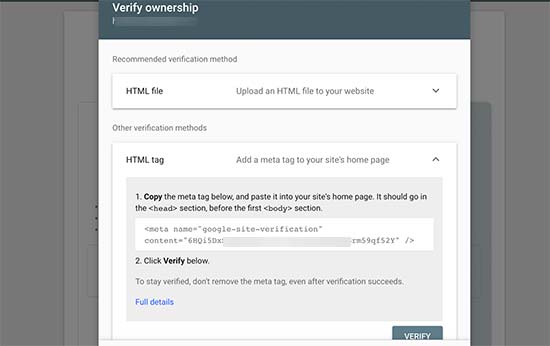
Simply copy the code on the screen and then go to the admin area of your WordPress website.
If you are using AIOSEO, then it comes with easy webmaster tools verification. Simply go to All in One SEO » General Settings and then click the ‘Webmaster Tools’ tab. After that, you can enter the code from Google there.
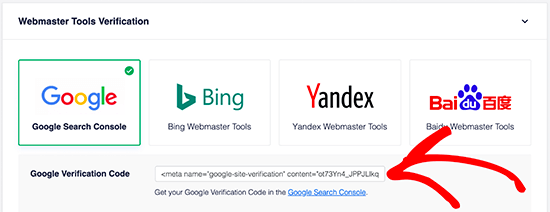
If you are not using AIOSEO, then you can enter the code using the WPCode plugin. This is the safest and easiest way to add code to your WordPress site.
You need to install and activate the WPCode Free Plugin. For more details, see our step-by-step guide on how to install a WordPress plugin.
Upon activation, you need to visit the Code Snippets » Header & Footer page and add the code you copied earlier into the ‘Header’ box.
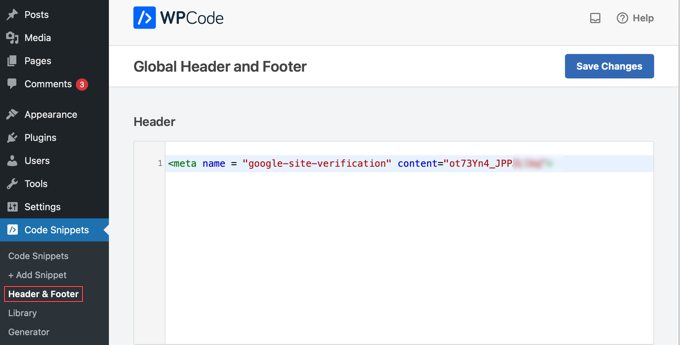
Don’t forget to click on the ‘Save Changes’ button to store your changes.
Now, switch back to the Google Search Console tab and click on the ‘Verify’ button.
Google will check for a verification code on your site and then add it to your Google Search Console account.
Note: If the verification is unsuccessful, then please make sure to clear your cache in WordPress and then try again.
Now that you have added your website, let’s add your XML sitemap as well.
From your account dashboard, you need to click on ‘Sitemaps’ from the left column.

After that, you need to add the last part of your sitemap URL under the ‘Add a new sitemap’ section and click the ‘Submit’ button.
Google will now add your sitemap URL to your Google Search Console.
It will take Google some time to crawl your website. After a while, you will be able to see basic sitemap stats.
This information includes the number of links Google found in your sitemap, how many of them got indexed, the ratio of images to web pages, and more.
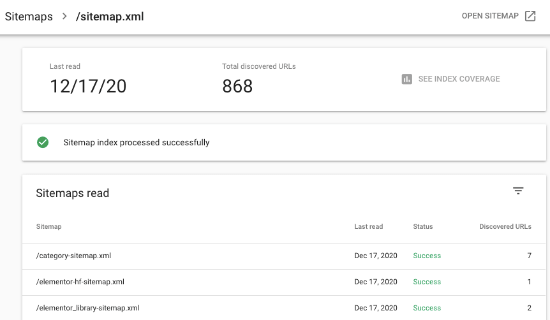
Submitting Your XML Sitemap to Bing
Similar to Google Search Console, Bing also offers Bing Webmaster Tools to help website owners monitor their website in the Bing search engine.
To add your sitemap to Bing, you need to visit the Bing Webmaster Tools website.
Here, you will see two options to add your site. You can either import your site from Google Search Console or add it manually.
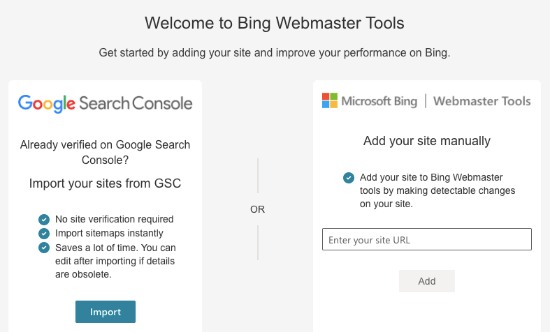
If you’ve already added your site to Google Search Console, we suggest importing your site. It saves time as your sitemap will automatically be imported for you.
If you choose to add your site manually, you need to enter your site’s URL and verify the site.
Bing will now ask you to verify the ownership of your website and will show you several methods to do that.
We recommend using the Meta tag method. Simply copy the meta tag line from the page and head over to your WordPress admin area.
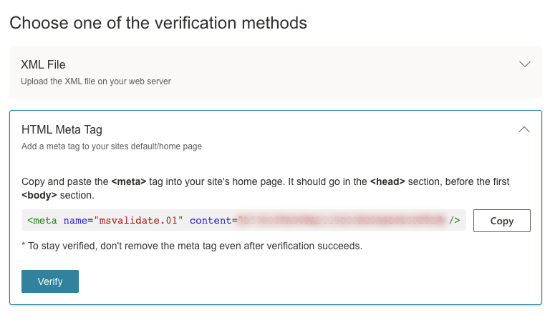
Now, install and activate the WPCode Free Plugin on your website
Upon activation, you need to visit the Code Snippets » Header & Footer page and add the code you copied earlier into the ‘Header’ box.
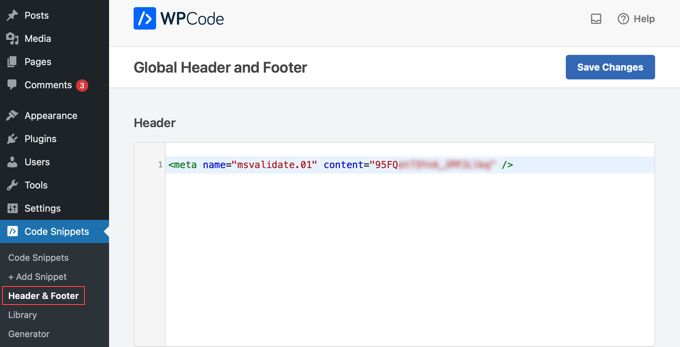
Don’t forget to click on the ‘Save Changes’ button to store your changes.
Using XML Sitemaps to Grow Your Website
Now that you have submitted the XML sitemap to Google and Bing, let’s take a look at how to utilize it for your website.
First, you need to keep in mind that the XML sitemap does not improve your search rankings. However, it does help search engines find content, adjust crawl rate, and improve your website’s visibility in search engines.
You need to keep an eye on your sitemap stats in Google Search Console. It can show you crawl errors and the pages excluded from search coverage.
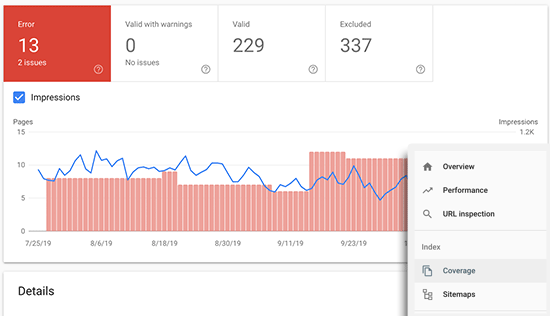
Below the charts, you can click on the different tables.
Here, you can view which actual URLs have been excluded or not indexed by Google.
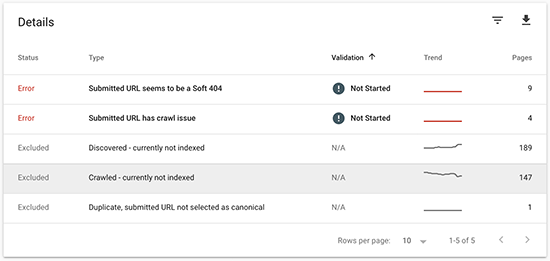
Normally, Google may decide to skip duplicate content, pages with no content or very little content, and pages excluded by your website’s robots.txt file or meta tags.
However, if you have an unusually high number of excluded pages, then you may want to check your SEO plugin settings to make sure that you are not blocking any content.
For more details, see our complete Google Search Console guide for beginners.
We hope this article helped you learn about XML sitemaps and how to create an XML sitemap for your WordPress site. You may also want to see our guide on how to quickly increase your website traffic with step-by-step tips and our expert picks for the best keyword research tools to write better content.
If you liked this article, then please subscribe to our YouTube Channel for WordPress video tutorials. You can also find us on Twitter and Facebook.





Syed Balkhi says
Hey WPBeginner readers,
Did you know you can win exciting prizes by commenting on WPBeginner?
Every month, our top blog commenters will win HUGE rewards, including premium WordPress plugin licenses and cash prizes.
You can get more details about the contest from here.
Start sharing your thoughts below to stand a chance to win!
Christopher Ebling says
I only get options that say Dashboard Search Console and Go Premium I don’t see site map as an option how do I get it to do the site map so I have to pay the 97$
WPBeginner Support says
Hey Christopher,
The option is moved to the advanced settings pages. Please see our updated guide on setting up Yoast SEO plugin and check step 3 which shows how to enable advanced settings and then step 9 which shows how to enable sitemaps.
Admin
Deepika Bisht says
Yoast seo best way to create a good sitemap for a wordpress blog. Thanks for share it.
Mahmoud says
i already have my sitemap XML , but i need to regenerate it .
what is the best way to do that ?
chittara says
OMG it helped me loads and loads…thanks a lot
Shane Jackson says
Thanks, this helped a lot!
Vin Boris says
Very informative content. It is a good information with good knowledge, my most of doubts get cleared with this.
Justin Lanouette says
how do you add a sitemap to wordpress.com sites?
Abdul Asif says
can you explain, what must be included in sitemaps, whether all posts, category, tags etc..
Angela - CRD Founder says
Amazing article! no-one could explain the Sitemap thing better than you. Thanks so much!! I’ve just followed all the steps (for the verification method, I chose “Domain Name Provider”, by the way)
So my website is roughly a month old and I’ve only just added the YOAST plugin and sitemap today. How much time does it take for Google to recognize it? Right now, I have this message in my Webmaster Tools:
“Error details: 1 Errors, 0 Warnings.
“We encountered an error while trying to access your Sitemap. Please ensure your Sitemap follows our guidelines and can be accessed at the location you provided and then resubmit.
“Network unreachable: Network unreachable”
What does it mean, please?
andy says
thanks! this is great!
Valentine says
Nothing to comment again because the process was straight forward. Thanks so much
WPBeginner Support says
You are welcome.
Admin
Toma says
First off, I`d like to say “thank you” for all your support and guidance to the new WP users.
I`ve created a sitemap, however Google is telling me that the URL is restricted by robots.txt
My robots.txt file look like this:
User-agent: *
Disallow: /
Sitemap: http://www.example.com/sitemap.xml
Checks:
sitemap.xml has been tested and is working as expected.
I`ve checked the site variants (www and non-www)
I understand that in WP Admin, under Search Engine Visibility it is possible to encourage search engines to index the site. My understanding is that doing so will modify the robots.txt file and will allow all robots to crawl my site – including the “bad” crawlers (I`ve read this on other tutorials).
Any further assistance will be greatly appreciated.
Regards,
Toma.
WPBeginner Support says
Your Robots.txt file is blocking search engines. You need to change that immediately. Try this and then check again with Google webmaster tools.
User-agent: *
Disallow:
SITEMAP: http://www.example.com/sitemap.xml
Admin
danielsonjosh says
this is fabulous!!!!!! great work
Abhinav says
The yoast sitemap page is showing “Warning: Class __PHP_Incomplete_Class has no unserializer in /home/content/n3pnexwpnas01_data02/78/3160178/html/wp-content/object-cache.php on line 520”, followed by url’s. This is the case with sitemap_index as well as sitemaps contained within. Sometime it shows right format and sometimes the similar error for the same post/page/index sitemap. How can I fix this?
Quanglepro says
Hello,
Your tip is very detail. But can i ask some more thing. I am new wordpresser from Viet Nam, I meet the problem with sitemap of Yoast seo.
After Save changes the Sitemap of Yoast, Then i go to Google console to add ” sitemap_index.xml ” for index.
After add sitemap_index.xml, It just show the blue color culumn, dont have any red color column for Index.
It is PASS or FAIL? How can i know google console indexed my sitemap or Not index for this case.
Nice day
Quangle
WPBeginner Support says
If there is an error, Google will display the error. Otherwise you should see your sitemap accepted.
Admin
Quanglepro says
It is done sir. After 2 days, it will be indexed. Google doesnt index immediately.
Nice day.
ArParvez says
dear sit iam seeing ur video and tutorial, using how to seo wordprees ytoast. i have done it, but when i try to see xml file it tell error/page not found but when i test this link on google sitemap it say no error found, but its empty. what should i do. and also i am getting problem using wordprees, i think i have done some mistake to install wp. i have install via Android phn.and sometime when i want to delete some plugin it tell error database,can u guys help me to reinstall wordprees pls it will be greatfull. tnx
WPBeginner Support says
It seems that WordPress is unable to connect to database server. Please take a look at our guide on how to fix the error establishing database connection in WordPress.
Alessio says
Hi guys,
do I still need a dedicated plugin for the sitemap or does the latest version of WP come with something for the sitemap too?
WPBeginner Support says
WordPress does not come with built-in sitemaps.
Admin
suji says
After installing Yoast plugin i got the below msg!
The plugin Yoast SEO has been detected. Do you want to import its settings into All in One SEO Pack?
wat do i need to do?
WPBeginner Support says
You need to disable All in One SEO plugin. Yoast SEO and All in One SEO are both SEO plugins. Having both of them enabled on your site may cause serious problems.
Admin
Suji says
Hi,
Thanks for the reply. I disabled All in one SEO plugin. I have one more query. Can you pls answer it?
I have already verified my site using HTML file upload method, so now how can i generate a sitemap using Yoast SEO plugin?
Summer Breeze says
Thank you so much! This was immensely helpful.
Jacqui Rawson says
Thanks guys!
This was really helpful.
You’re making my stress levels deflate immensely with all your assistance on getting my site all SEO set up.
Cheers
Emma says
Thank you for the step-by-step instructions – really helped me to understand WP and Google further.
Keep up the good work!
Abhyank says
“If you have a sitemap that is located on example.com/sitemap.xml, your sitemap is not being generated by our Yoast SEO plugin. It is probably generated by Google XML Sitemaps or another XML sitemaps plugin. Please disable other sitemap plugins and remove any sitemap files via FTP before enabling the sitemaps in our plugin.”
How do i get around this?
WPBeginner Support says
Simply go to your plugins page. See if you have a plugin installed that adds XML sitemap. If you do, then disable that plugin.
Admin
Abhyank says
I really can’t figure out if any of my plugins are making a sitemap, i don’t think i have installed any that do. So terribly confused.
WPBeginner Support says
Then try disabling all plugins except Yoast SEO. Then try go to sitemaps, if you don’t see the message then this means one of the plugin was causing that. You can then activate plugins one by one and visit the sitemaps screen to see if the error reappears. Do that until you find the plugin causing it.
On the other hand if you see the message even after deactivating all plugins, then it could be your WordPress theme or a manually created file on your server.
Yuvraj Khavad says
Hello,
Thanks for this tutorial.
Very mush informative post.
Thanks
Yuvraj Khavad
Dawit says
Thanks! very helpful.
Erin says
Thank you for this informative article.
I have notice that some of my pages are not included in the sitemap generated in WordPress using the Yoast SEO – XML sitemap tool. Is there a way to manually enter the missing pages or to update the sitemap to include these pages?
Galib says
Really easy to follow and create a site map!!
Jo says
Thank you! I think I have created what was needed and it was easy. Instructions were clear and easy to follow, thank you.
Annika says
Hi there,
I’ve read through a lot of pages trying to explain what you did, but seriously, yours is BY FAR the best. Easy to understand, one-by-one explanations. Thanks for your great help, you probably just saved me hours and hours of work.
Cheers,
Annika
WPBeginner Support says
Thanks, we are glad you found it helpful.
Admin
Magaly says
Great info, very useful!

Now will wait for Google Analitycs to do his work
Suraj says
Very helpful article n screenshots makes it easy to understand!! Thanks for posting!!
kksilvery says
Hi,
It was easy to understand. My question is , how can i edit my blog current sitemap?
Regards,
kksilvery.
Kay Collier says
Thank you once again for more valuable information.
Josh Watson says
SUPER useful article! I really appreciate the info! This saved me so much time and hassle. I had looked at a couple other guides and they were just confusing.
I used this on my site and it really saved us!
Shailesh Jangra says
Hi Syed Balkhi,
Great post over sitemaps. I have one question for you.
I have sitemap_index.xml for my website (without www ) but now I set my website to www version. I can see that all pages automatically changes with www version but sitemap_index dosn’t. Any specific reason.
Also it shows nothing on but at sitemap_index.xml page I have complete sitemap.
What is the mistake?
WPBeginner Support says
Since you have set your website URL on www your sitemap will be published on the same URL.
Admin
zeeshan khan says
My site map shows the staticstics of web page but not show the staticstics of images. why not show image in my site map help me please.
Tom Horn says
Whenever I submit the sitemap this is the message I get:
“Your Sitemap does not contain any URLs. Please validate and resubmit your Sitemap.”
Can you tell me what to do? Thanks.
Leo says
I am having serious problems regarding sitemaps for a few months ago. I am using a wordpress hosted by godaddy. I’ve installed SEO by Yoast and did the sitemaps tutorial you had. Site’s is connecting, the sitemap is there, but the specific links (posts, pages, author, etc) are pending.
We wait 48 hours, and none. We try it so many times, re-submitted, and yet Google search console is not crawling our site correctly.
I don’t know what to do! Does it has to do with our theme? Godaddy told us there’s nothing blocking it on their side. And every time i look on the internet, many people are still having the same issue. Noticed that our site is working correctly and so are the feeds. But we are not crawling anything… Please if somebody already solved this, tell us, maybe someone else will going to solve this terrible issue
Jess @ Make and Do Crew says
Thanks for this! It’s the clearest explanation I’ve seen. How long does it take for Google to crawl it? I can’t seem to get to that final visual you showed with the total number of pages and images indexed, although I haven’t gotten any sort of message that google is still working on it. Like, should I check back tomorrow? And if so, can you tell me exactly what to click on to find the confirmation that the site has been fully crawled? Thanks again!
WPBeginner Support says
Give it at least 48 hours.
Admin
John says
Thanks for the info. As an addition: if the sitemap url gives a 404 then try lowering the default value of 1000 for the maximum number of lines. Worked for me.
Tamsin says
Thank you for your solution. I changed the default value to 200 and it works! I have spent the last week trying to get my head around this stuff being a complete beginner. You have saved my sanity.
Israel says
please, after i clicked on the XML Sitemap
what i got is error,
Error 404 Not Found
Oops! We couldn’t find this Page.
Please check your URL or use the search form below.
Please what can i do to get mu sitemp. thanks
Taranpreet Singh says
same problem is with me. have you solved the problem.
Austin says
Same issue, no sitemap on my free .wordpress.com site. How do we fix this or create one?
ramin ziafat says
thank you it was great
surya teja says
thank you for the great article .
i am having a problem . i am using free wordpress of name ( free domain sitename.wordpress.com ) i am not understanding how to add the site map at now
WPBeginner Support says
Please see our guide on the difference between WordPress.com and WordPress.org.
Admin
Nitika says
nice article! apart from this do we need to enter google authorisation code?
Leo says
Hi,
Thank you so much for the easy-to-follow instructions and well explained topic about sitemaps.
My question is How to add a ‘single’ page or post which displays all your posts. I hope you got what i mean.
I saw a blog, at the bottom of the page there is a clickable link called ‘sitemap’. when you click it, it will bring you to a page containing all the published post or articles or i suppose, “the sitemaps”.
How can i do these type of ‘clickable link’???
Thank you very much.
WPBeginner Support says
You can try this plugin.
Admin
Naveen says
Nice article ! But when i submitted the sitemap, it is showing 0 url submitted at the dashbard area
Kris letcher says
Thanks for the concise information.
Kris
Deb Slater says
Wow. wpbeginner is the very best instruction I have found for my WordPress site. Thank you.
Harrison Okoyibo says
I just want to say a big “THANK YOU” for your efforts providing the internet wordpress users with useful, and relevant information, articles, and tutorials. Wishing you and your team more of God’s blessing. Shalom!
Luigi says
Thank you for this tutorial! It was really helpful!
Ana says
Thank you for your tutorial and info. It really helped me with the sitemap! Great job!
Ezekiel says
Thank you for this explanation. I am indeed grateful for it.
Your tutorials in this site has always been helpful
Kaleem Ullah says
Your Sitemap appears to be an HTML page. Please use a supported sitemap format instead. need help